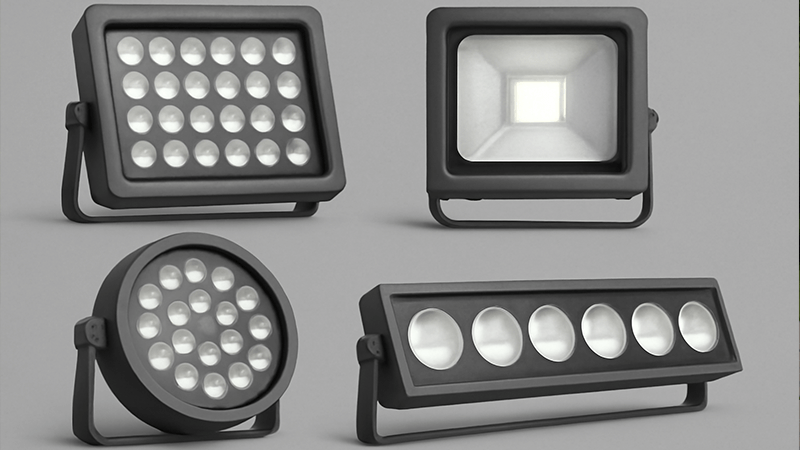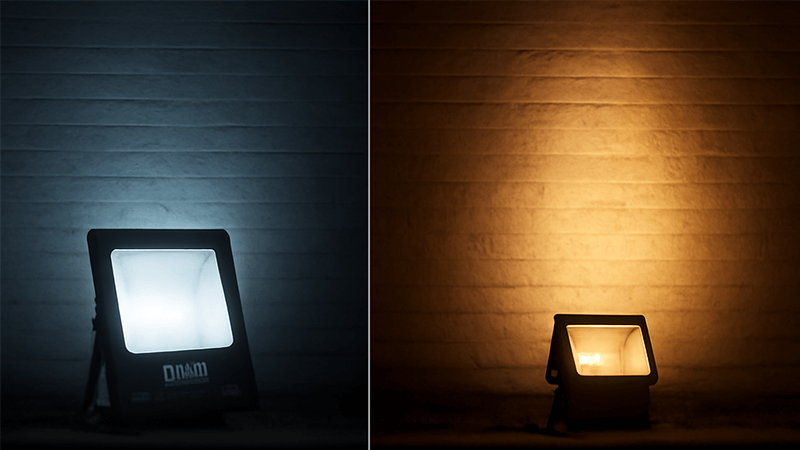Struggling to find the perfect flood light? The wrong choice can waste money and fail to illuminate your space properly. Let’s find the right one for your specific needs.
The best type of flood light depends entirely on your specific needs, budget, and where you’ll use it. Key factors include the area size, desired brightness (lumens), and energy efficiency goals. There isn’t one perfect light for every job; it’s about matching the product to the project.

Choosing the right flood light can feel overwhelming. I’ve been in the LED lighting industry for many years, first working in a factory and now running my own manufacturing business, Upward Lighting. I’ve seen clients like Shaz, a seasoned purchasing manager from the UAE, grapple with this same question. The truth is, the "best" light is a myth. The right light, however, is something we can definitely find. To do that, we need to answer a few key questions about what you’re trying to achieve. Let’s walk through them together.
What is a 200W LED flood light equivalent to?
Confused by wattage equivalents when switching to LED? You might worry a new 200W LED won’t be as bright as your old power-hungry lights. Here’s a simple explanation.
A 200W LED flood light is roughly equivalent to a 1000W metal halide or a 2000W halogen flood light. The key is to look at lumens, not just watts. A 200W LED typically produces 20,000 to 30,000 lumens, offering huge energy savings with comparable brightness.

For years, we all talked about lighting in terms of watts. If you needed a brighter light, you bought a higher-wattage bulb. That thinking is outdated, especially with LED technology. When I work with experienced buyers, the conversation has completely changed. We no longer start with watts; we start with lumens. Watts measure how much energy a light consumes, while lumens measure how much light it actually produces. This distinction is the most important concept to understand when choosing modern lighting. An efficient light gives you more lumens for fewer watts.
From Watts to Lumens
The old way of thinking worked because older technologies like halogen and metal halide were similarly inefficient. A 1000W halogen was always brighter than a 500W one. LEDs changed the game because they are incredibly efficient. They produce a massive amount of light (lumens) using very little energy (watts). This efficiency is measured in "lumens per watt" (lm/W). The higher the lm/W, the more light you get for your money.
A Clear Comparison
Let’s look at the numbers. This makes it very clear why a 200W LED can replace a 2000W halogen. The LED simply does a much better job of turning electricity into light instead of wasting it as heat.
| Light Type |
Typical Power (Watts) |
Typical Brightness (Lumens) |
Efficacy (lm/W) |
| Halogen |
2000W |
~24,000 lm |
~12 lm/W |
| Metal Halide |
1000W |
~25,000 lm |
~25 lm/W |
| LED |
200W |
~26,000 lm |
~130 lm/W |
As you can see, the 200W LED produces even more light than the other two options while using a fraction of the power. So, a 200W LED is not just an equivalent; in many ways, it’s a massive upgrade.
How bright is a 3000 lumens floodlight?
Do you see "3000 lumens" on a box and wonder what that really means? It can be hard to visualize brightness from just a number. Let me help you understand it.
A 3000-lumen floodlight is quite bright, suitable for residential use like illuminating driveways, backyards, or building entrances. It provides strong security lighting and is roughly equivalent to a 200-watt halogen bulb, but it uses only about 30 watts of power in LED form.

Understanding lumens is about connecting the number to a real-world application. A number like 3000 lumens can seem abstract, but it’s a very common and useful brightness level. I often recommend this range to clients who need effective lighting for medium-sized areas without creating the intense glare of a stadium light. It hits a sweet spot between visibility and comfort. It’s about finding the right tool for the job. You wouldn’t use a sledgehammer to hang a picture, and you don’t need 50,000 lumens to light up your front porch.
Visualizing 3000 Lumens
Think of it this way: a standard 60-watt incandescent bulb that you’d use in a lamp produces about 800 lumens. A 3000-lumen floodlight is nearly four times as bright. This is more than enough to turn a dark backyard into a well-lit, secure space. You can comfortably see across your yard, identify any movement, and feel much safer. It’s bright enough to deter intruders and light up pathways clearly.
Where to Use a 3000-Lumen Floodlight
This level of brightness is perfect for specific tasks. I’ve supplied countless 30-watt, 3000-lumen floodlights for projects with these exact needs. Here are the most common uses:
- Residential Driveways: It will light up a two-car driveway completely, making it easy to park and walk to your door at night.
- Backyards and Patios: It can illuminate a medium-sized patio or a section of your yard for evening gatherings or for keeping an eye on pets.
- Building Entrances and Walkways: For small commercial buildings or apartment complexes, it provides excellent security and safety lighting around doorways and paths.
- Accent Lighting: You can use it to highlight architectural features or large trees on your property.
A 3000-lumen floodlight is a versatile and powerful tool for many common lighting needs. It delivers great security and usability without being overwhelmingly harsh.
How many watts should a flood light be?
Are you wondering how many watts to choose? This is a common question, but it’s actually the wrong one to ask. Let’s focus on what truly matters for your project.
The wattage of a floodlight depends on the required brightness (lumens). Instead of asking about watts, determine your lumen needs first. For small areas, 10W-30W (1000-3000 lm) is good. For larger areas like parking lots, you might need 150W-300W (20,000-40,000 lm).

When a client like Shaz sends me an inquiry, he rarely asks for a specific wattage anymore. He provides project details: the size of the area, the required brightness on the ground (measured in lux), and the application. This is the professional way to approach lighting. We’ve all learned to move beyond a simple watt number. The real goal is to get the right amount of light in the right place, and do it as efficiently as possible. Your focus should be on the outcome—the light itself—not on the energy consumed to create it.
Step 1: Define Your Goal (Lumens)
Before you even think about watts, you need to know how much light you need. This depends entirely on what you are lighting up. Different tasks require different levels of brightness.
- Low Light (700 – 3,000 lumens): Perfect for small garden paths, residential porches, and accenting small architectural details. This creates a gentle, welcoming light.
- Medium Light (4,000 – 10,000 lumens): Ideal for driveways, backyards, and the sides of commercial buildings. This is great for general security and visibility.
- High Light (15,000 – 40,000+ lumens): Needed for large areas like parking lots, sports fields, building facades, and construction sites. This is about powerful, wide-scale illumination.
Step 2: Find the Right Wattage
Once you know your target lumen range, you can find an LED flood light with the right wattage. Because LED efficiency (lm/W) can vary slightly between manufacturers and models, you should always check the lumen output on the product specifications. However, this table gives you a general idea of what to expect.
| Application |
Required Lumens |
Typical LED Wattage |
| Garden Path |
~1,000 lm |
10W |
| Driveway |
~3,000 lm |
30W |
| Building Security |
~7,500 lm |
50W |
| Small Parking Lot |
~15,000 lm |
100W |
| Large Area / Sports |
~30,000+ lm |
200W+ |
Always start with how much light you need (lumens), then find the most efficient product (lowest watts) that can deliver it. That’s how you get the best performance and save the most money.
Is it worth changing from halogen to LED?
Thinking about upgrading your old halogen floodlights? You might be wondering if the cost and effort of switching to LED are truly worth it. Let me make it simple for you.
Yes, it is absolutely worth changing from halogen to LED. The long-term benefits are huge. LEDs use up to 90% less energy, last over 20 times longer, and produce less heat, making them safer and far more cost-effective over their lifespan.

I see this question all the time. People have halogen lights that still work, and they wonder why they should spend money to replace them. The initial cost of an LED fixture is higher than a simple halogen bulb, and that can make people pause. But as a manufacturer, I see the whole picture. The upfront cost is a tiny part of the total cost of owning a light. When you factor in electricity bills, frequent bulb replacements, and the labor to change those bulbs, the decision becomes incredibly easy. The payback period for switching to LED is often surprisingly short.
The Financial Case
Let’s break down the numbers with a real-world example. Imagine you have a single 500W halogen floodlight that you run for 8 hours every night.
| Metric |
500W Halogen |
50W LED (Equivalent) |
Your Savings with LED |
| Energy Use (kWh/year) |
1460 kWh |
146 kWh |
1314 kWh/year |
| Electricity Cost (@$0.15/kWh) |
$219/year |
$21.90/year |
$197.10 per year |
| Lifespan |
~2,000 hours |
~50,000 hours |
25x longer |
| Replacements (over 50k hrs) |
25 bulbs |
0 bulbs |
25 bulb purchases saved |
The energy savings alone are massive. For a single light, you save nearly $200 every year. If you have ten lights, that’s $2,000 a year back in your pocket. The LED fixture pays for itself very quickly.
Beyond the Money
The benefits go far beyond just the electricity bill.
- Drastically Reduced Maintenance: Halogen bulbs burn out constantly, often lasting less than a year. An LED fixture can last for a decade or more. Think about the cost and hassle of hiring someone to climb a ladder to replace bulbs on a tall building. With LED, you install it and forget it.
- Improved Safety: Halogen bulbs get incredibly hot. They can be a fire hazard if placed too close to flammable materials. LEDs run much cooler, making them significantly safer for any application.
- Better Light Quality: LEDs provide a much cleaner, more consistent light. They don’t flicker, and you can choose from various color temperatures to get the exact look you want.
Switching to LED is not just an upgrade; it’s a smart business decision. The financial and operational benefits are too significant to ignore.
Conclusion
The best flood light is the one that perfectly fits your project’s needs for brightness, area coverage, and efficiency. Focus on lumens first, then find the right wattage to match.